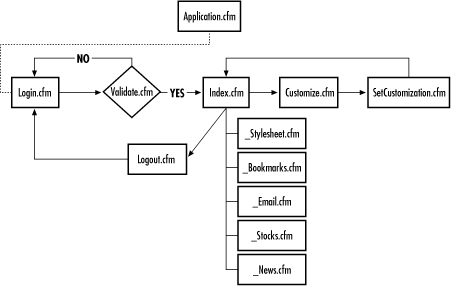Portal Example
Because state management is such an
important part of web application development, I think it’s
appropriate we end the chapter with an example application that
showcases the material we’ve just covered. I’ve opted to
create a portal application, that allows a registered visitor to
create a personalized home page from a list of prebuilt components,
as it is sufficiently complex to allow me to demonstrate a number of
techniques. Figure 7-6 shows an overview of how the
portal application is put together, including relationships between
the various templates. The application uses all the persistent
variable scopes we discussed with the exception of the server scope.
We’ll cover all of the templates used in the application except
for Login.cfm and
Validate.cfm. These templates are discussed in
Chapter 8.

Figure 7-6. Application flow for the portal example
Web Application Framework
The
Application.cfm template shown in Example 7-2 has four functions in the portal application:
it turns on client and session management, handles authentication,
expires the session when appropriate, and sets application variables.
Example 7-2. Application.cfm Template for the Portal Application
<CFSETTING ENABLECFOUTPUTONLY="Yes"> <CFAPPLICATION NAME="MyApplication" CLIENTMANAGEMENT="Yes" SESSIONMANAGEMENT="Yes" SETCLIENTCOOKIES="Yes" SESSIONTIMEOUT="#CreateTimeSpan(0, 0, 30, 0)#" APPLICATIONTIMEOUT="#CreateTimeSpan(0, ...
Get Programming ColdFusion now with the O’Reilly learning platform.
O’Reilly members experience books, live events, courses curated by job role, and more from O’Reilly and nearly 200 top publishers.

